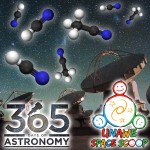Podcaster: Richard Drumm
 Title: Space Scoop: The Building Blocks of Life
Title: Space Scoop: The Building Blocks of Life
Organization: 365 Days Of Astronomy
Link : astrosphere.org ; http://unawe.org/kids/unawe1528/
Description: Space scoop, news for children.
Bio: Richard Drumm is President of the Charlottesville Astronomical Society and President of 3D – Drumm Digital Design, a video production company with clients such as Kodak, Xerox and GlaxoSmithKline Pharmaceuticals. He was an observer with the UVa Parallax Program at McCormick Observatory in 1981 & 1982. He has found that his greatest passion in life is public outreach astronomy and he pursues it at every opportunity.
Today’s sponsor: This episode of “365 Days of Astronomy” is sponsored by — no one. We still need sponsors for many days in 2015, so please consider sponsoring a day or two. Just click on the “Donate” button on the lower left side of this webpage, or contact us at signup@365daysofastronomy.org.
Transcript:
This is 365 Days of Astronomy. Today we bring you a new episode in our Space Scoop series. This show is produced in collaboration with Universe Awareness, a program that strives to inspire every child with our wonderful cosmos.
Today’s story is…
The Building Blocks of Life
You can build some pretty amazing things simply by sticking lego blocks together. People have made life-sized lego houses, lego rockets and even lego ships! Just like these impressive lego structures, humans are built of tiny pieces too. Human building blocks are called organic molecules. They look more like Tinkertoys, though.
Unlike these toys, molecules are so small that nobody can see them, except with extremely powerful microscopes. They are made up of chemicals like carbon, hydrogen and oxygen. Organic molecules, the ones that are based on carbon, have been found all over the Universe.
Now, no-one knows how life began on Earth 3 and a half billion years ago, but one thing is certain; it all began with these tiny organic molecules.
But if organic molecules are the building blocks of life and they exist all over the Universe, why haven’t we found life beyond Earth?
Well, organic molecules are very fragile. They don’t often survive the harsh radiation surrounding new-born stars. However, scientists have just detected huge amounts of organic molecules around a young star called MWC 480. It’s the 480th entry in the Mount Wilson Catalog of young stars and is 455 light years away in the constellation Taurus.
A team of astronomers using ALMA, the Atacama Large Millimeter/submillimeter Array radiotelescope in Chile, found lots of methyl cyanide and hydrogen cyanide around that star. These are two organic molecules that are important building blocks for life as we know it, and they are precursors for amino acids, which are the building blocks in their own turn for proteins.
These building blocks, being highly reactive, are toxic as all heck to us now that we’re alive, but because of the reactions they can participate in, they were useful for forming life’s key molecules on the early Earth.
This new-born star doesn’t have any planets yet as it’s just a million years old, but it is surrounded by a disc of planet-making material that will soon form into planets. It is in the outer edge of this disc, where the solar system’s icy comets will form, that astronomers found the organics.
In a few millions years, newly formed comets from the disk’s outer regions will start to rain down on the planets. And those organic molecules will be carried with them. Who knows what kind of strange things could be built with them when they land?
Hey, Here’s a Cool Fact:
Most scientists think that it was comets just like we described here that brought organic molecules to Earth in the early days of our Solar System! Both comets from the Kuiper Belt and asteroids from the asteroid belt hit Earth during the so-called Late Heavy Bombardment or LHB for short, about 4 billion years ago.
It’s possible that the gas giant planets migrated in their orbits back then, causing the solar system to become unstable when Jupiter & Saturn reached a 2:1 orbital resonance. Various other resonances would have swept through the asteroid & Kuiper belts, starting the LHB and bringing the organics down to Earth.
Thank you for listening to 365 Days of Astronomy!
End of podcast:
365 Days of Astronomy
=====================
The 365 Days of Astronomy Podcast is produced by NUCLIO. Audio post-production by Richard Drumm. Bandwidth donated by libsyn.com and wizzard media. You may reproduce and distribute this audio for non-commercial purposes. Please consider supporting the podcast with a few dollars (or Euros!). Visit us on the web at 365DaysOfAstronomy.org or email us at info@365DaysOfAstronomy.org. This year we celebrate cosmic light as light is our info messenger in the universe. Join us and share your story to celebrate the International Year of Light. Until tomorrow! Goodbye!

